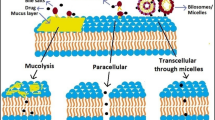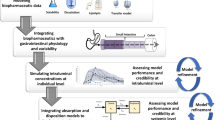Abstract
This study investigated the dissolution behavior of BCS class II ionizable weak base Saquinavir and its mesylate salt in the multi-compartment transfer setup employing different composition of dissolution media. The dissolution behavior of Saquinavir was studied by using a two-compartment transfer model representing the transfer of drug from the stomach (donor compartment) to the upper intestine (acceptor compartment). Various buffers like phosphate, bicarbonate, FaSSIF, and FeSSIF were employed. The dissolution was also studied in the concomitant presence of the additional solute, i.e., Quercetin. Further, the dissolution profiles of Saquinavir and its mesylate salt were simulated by GastroPlusTM, and the simulated dissolution profiles were compared against the experimental ones. The formation of in situ HCl salt and water-soluble amorphous phosphate aggregates was confirmed in the donor and acceptor compartments of the transfer setup, respectively. As the consequence of the lower solubility product of HCl salt of Saquinavir, the solubility advantage of mesylate salt was vanished leading to the lower than the predicted dissolution in the acceptor compartment. However, the formation of water-soluble aggregates in the presence of the phosphate salts was observed leading to the higher than the predicted dissolution of the free base in the transfer setup. Interestingly, the formation of such water-soluble aggregates was found to be hindered in the concomitant presence of an ionic solute resulting in the lower dissolution rates. The in situ generation of salts and aggregates in the transfer model lead to the inconsistent prediction of dissolution profiles by GastroPlusTM.













Similar content being viewed by others
References
Di L, Fish PV, Mano T. Bridging solubility between drug discovery and development. Drug Discov Today. 2012;17(9–10):486–95.
Serajuddin ATM. Salt formation to improve drug solubility. Adv Drug Deliv Rev. 2007;59(7):603–16.
Hsieh Y-L, Merritt JM, Yu W, Taylor LS. Salt stability—the effect of pHmax on salt to free base conversion. Pharm Res. 2015;32(9):3110–8.
Hsieh Y-L, Ilevbare GA, Van Eerdenbrugh B, Box KJ, Sanchez-Felix MV, Taylor LS. pH-induced precipitation behavior of weakly basic compounds: determination of extent and duration of supersaturation using potentiometric titration and correlation to solid state properties. Pharm Res. 2012;29(10):2738–53.
Trasi NS, Taylor LS. Thermodynamics of highly supersaturated aqueous solutions of poorly water-soluble drugs—impact of a second drug on the solution phase behavior and implications for combination products. J Pharm Sci. 2015;104(8):2583–93.
Taylor LS, Zhang GGZ. Physical chemistry of supersaturated solutions and implications for oral absorption. Adv Drug Deliv Rev. 2016;101:122–42.
Tanaka Y, Sugihara M, Kawakami A, Imai S, Itou T, Murase H, et al. In vivo analysis of supersaturation/precipitation/absorption behavior after oral administration of pioglitazone hydrochloride salt; determinant site of oral absorption. Eur J Pharm Sci. 2017;106:431–8.
Tanaka Y, Kawakami A, Nanimatsu A, Horio M, Matsuoka J, Wada T, et al. In vivo evaluation of supersaturation/precipitation/re-dissolution behavior of cinnarizine, a lipophilic weak base, in the gastrointestinal tract: the key process of oral absorption. Eur J Pharm Sci. 2017;96:464–71.
Bou-Chacra N, Melo KJC, Morales IAC, Stippler ES, Kesisoglou F, Yazdanian M, et al. Evolution of choice of solubility and dissolution media after two decades of biopharmaceutical classification system. AAPS J. 2017;19(4):989–1001.
Sheng JJ, McNamara DP, Amidon GL. Toward an in vivo dissolution methodology: a comparison of phosphate and bicarbonate buffers. Mol Pharm. 2009;6(1):29–39.
Kostewicz ES, Wunderlich M, Brauns U, Becker R, Bock T, Dressman JB. Predicting the precipitation of poorly soluble weak bases upon entry in the small intestine. J Pharm Pharmacol. 2004;56(1):43–51.
Ruff A, Fiolka T, Kostewicz ES. Prediction of ketoconazole absorption using an updated in vitro transfer model coupled to physiologically based pharmacokinetic modelling. Eur J Pharm Sci. 2017;100:42–55.
Higashino H, Hasegawa T, Yamamoto M, Matsui R, Masaoka Y, Kataoka M, et al. In vitro-in vivo correlation of the effect of supersaturation on the intestinal absorption of BCS class 2 drugs. Mol Pharm. 2014;11(3):746–54.
Tsume Y, Matsui K, Searls AL, Takeuchi S, Amidon GE, Sun D, et al. The impact of supersaturation level for oral absorption of BCS class IIb drugs, dipyridamole and ketoconazole, using in vivo predictive dissolution system: gastrointestinal simulator (GIS). Eur J Pharm Sci. 2017;102:126–39.
Psachoulias D, Vertzoni M, Butler J, Busby D, Symillides M, Dressman J, et al. An in vitro methodology for forecasting luminal concentrations and precipitation of highly permeable lipophilic weak bases in the fasted upper small intestine. Pharm Res. 2012;29(12):3486–98.
Jantratid E, Janssen N, Reppas C, Dressman JB. Dissolution media simulating conditions in the proximal human gastrointestinal tract: an update. Pharm Res. 2008;25(7):1663–76.
Sugawara M, Kadomura S, He X, Takekuma Y, Kohri N, Miyazaki K. The use of an in vitro dissolution and absorption system to evaluate oral absorption of two weak bases in pH-independent controlled-release formulations. Eur J Pharm Sci. 2005;26(1):1–8.
Jensen KT, Blaabjerg LI, Lenz E, Bohr A, Grohganz H, Kleinebudde P, et al. Preparation and characterization of spray-dried co-amorphous drug-amino acid salts. J Pharm Pharmacol. 2016;68(5):615–24 Available from: http://doi.wiley.com/10.1111/jphp.12458.
Galia E, Nicolaides E, Hörter D, Löbenberg R, Reppas C, Dressman JB. Evaluation of various dissolution media for predicting in vivo performance of class I and II drugs. Pharm Res. 1998;15(5):698–705.
Marques M. Dissolution media simulating fasted and fed states. Dissolution Technol. 2004;11(2):16–9.
Augustijns P, Wuyts B, Hens B, Annaert P, Butler J, Brouwers J. A review of drug solubility in human intestinal fluids: implications for the prediction of oral absorption. Eur J Pharm Sci. 2014;57:322–32.
McNamara DP, Whitney KM, Goss SL. Use of a physiologic bicarbonate buffer system for dissolution characterization of ionizable drugs. Pharm Res. 2003;20(10):1641–6.
Avdeef A. Phosphate precipitates and water-soluble aggregates in re analyzed solubility-pH data of twenty-five basic drugs. ADMET DMPK. 2014;2(1):43–55.
Aunins JG, Southard MZ, Myers RA, Himmelstein KJ, Stella VJ. Dissolution of carboxylic acids III: the effect of polyionizable buffers. J Pharm Sci. 1985;74(12):1305–16.
Pathak SM, Musmade P, Dengle S, Karthik A, Bhat K, Udupa N. Enhanced oral absorption of saquinavir with methyl-beta-cyclodextrin—preparation and in vitro and in vivo evaluation. Eur J Pharm Sci. 2010;41(3–4):440–51.
Sakhare SD, Anand VSK, Karan A, Sree KN, Vasantharaju SG, Pai G, et al. The assessment of pH-induced supersaturation and impact of an additional drug on the solution phase behavior of saquinavir. J Pharm Innov. 2018:1–11.
Erlund I. Review of the flavonoids quercetin, hesperetin, and naringenin. Dietary sources, bioactivities, bioavailability, and epidemiology. Nutr Res. 2004;24(10):851–74.
Alluis B, Dangles O. Quercetin (= 2(3,4 dihydroxyphenyl) 3,5,7 trihydroxy 4H 1 benzopyran 4 one) glycosides and sulfates: chemical synthesis, complexation, and antioxidant properties. Helv Chim Acta. 2001;84(5):1133–56.
Jullian C, Moyano L, Yanez C, Olea-Azar C. Complexation of quercetin with three kinds of cyclodextrins: an antioxidant study. Spectrochim Acta A Mol Biomol Spectrosc. 2007;67(1):230–4.
Pekal A, Biesaga M, Pyrzynska K. Interaction of quercetin with copper ions: complexation, oxidation and reactivity towards radicals. Biometals. 2011;24(1):41–9.
Li S, Wong S, Sethia S, Almoazen H, Joshi YM, Serajuddin ATM. Investigation of solubility and dissolution of a free base and two different salt forms as a function of pH. Pharm Res. 2005;22(4):628–35.
Avdeef A, Fuguet E, Llinás A, Ráfols E, Bosch E, Völgyi G, et al. Equilibrium solubility measurement of ionizable drugs—consensus recommendations for improving data quality. ADMET DMPK. 2016;4(2):117–78.
Indulkar AS, Box KJ, Taylor R, Ruiz R, Taylor LS. pH-dependent liquid-liquid phase separation of highly supersaturated solutions of weakly basic drugs. Mol Pharm. 2015;12(7):2365–77.
Ward TM, Weber JB. Aqueous solubility of alkylamino-s-triazine as a function of pH and molecular structure. J Agric Food Chem. 1968;16(6):959–61.
CAS B, Luthman K, Artursson P. Accuracy of calculated pH-dependent aqueous drug solubility. Eur J Pharm Sci. 2004;22(5):387–98.
Dengale SJ, Hussen SS, Krishna BSM, Musmade PB, Gautham Shenoy G, Bhat K. Fabrication, solid state characterization and bioavailability assessment of stable binary amorphous phases of ritonavir with quercetin. Eur J Pharm Biopharm. 2015;89:329–38.
Greco K, Mcnamara DP, Bogner R. Solution-mediated phase transformation of salts during dissolution: investigation using haloperidol as a model drug. J Pharm Sci. 2011;100(7):2755–68.
Berlin M, Przyklenk K-H, Richtberg A, Baumann W, Dressman JB. Prediction of oral absorption of cinnarizine—a highly supersaturating poorly soluble weak base with borderline permeability. Eur J Pharm Biopharm. 2014;88(3):795–806.
Kostewicz ES, Aarons L, Bergstrand M, Bolger MB, Galetin A, Hatley O, et al. PBPK models for the prediction of in vivo performance of oral dosage forms. Eur J Pharm Sci. 2014;57:300–21.
Author information
Authors and Affiliations
Corresponding author
Ethics declarations
Conflict of Interest
The authors declare that they have no conflict of interest.
Additional information
Publisher’s Note
Springer Nature remains neutral with regard to jurisdictional claims in published maps and institutional affiliations.
Aman Urazov is an AIESEC visiting scholar.
Electronic Supplementary Material
ESM 1
(DOCX 1389 kb).
Rights and permissions
About this article
Cite this article
Chegireddy, M., Hanegave, G.K., Lakshman, D. et al. The Significance of Utilizing In Vitro Transfer Model and Media Selection to Study the Dissolution Performance of Weak Ionizable Bases: Investigation Using Saquinavir as a Model Drug. AAPS PharmSciTech 21, 47 (2020). https://doi.org/10.1208/s12249-019-1563-0
Received:
Accepted:
Published:
DOI: https://doi.org/10.1208/s12249-019-1563-0




